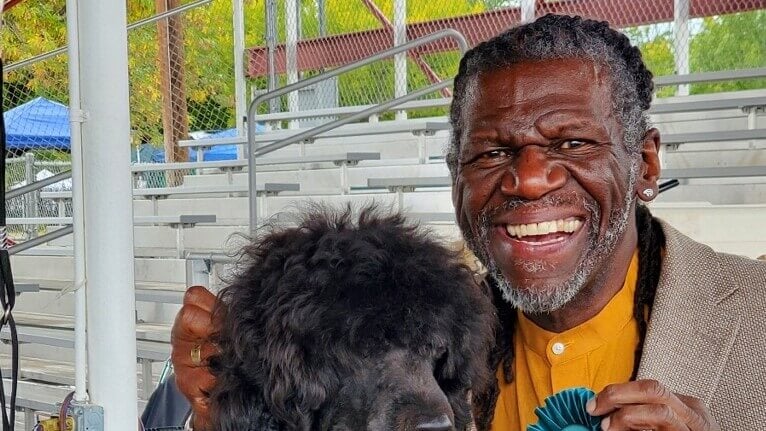


Home » Dr. Thomas Strain, MD | LaSerene Kennel Portuguese Water Dogs

Dr. Thomas Strain, MD
1. I am Thomas Strain, MD. I presently live in Northern Louisiana. My first spouse, kids, and I started in purebred dogs around 1983. We acquired our first Portuguese Water Dogs (PWD), call names Panda and Feisty, in September 1984. It was at that time that we decided to name our kennel LaSerene Kennel.
Since neither CH Windjammer Floco (aka Panda) nor his sister passed OFA, we acquired Regala’s Cierra Of La Serene from Ms. Eleanor Pierce of Regala’s Kennel in late 1986. She became our foundation bitch after passing her OFA and having the tests recommended by the PWDCA. She was also, for a while, the most-titled PWD bitch in the late ‘80s. She was International, South American, Puerto Rico, Am. CH Regala’s Cierra Of La Serene CD TD. Her first breeding took place after she was three years of age, in 1990. Prior to that time, in 1986, we had bred a litter of Rottweilers before deciding the family was more into this “new” breed of PWDs.
2. As a breeder, my main objective is to breed healthy family companions with good temperaments. So, with that in mind, I will spend a lot of time looking for dogs that have the type and temperament of this breed by researching all prospective candidates’ pedigrees and health data, and ask other breeders whom I respect their knowledge and insight about the candidates and their knowledge about any get, their siblings, and ancestral history which I may not be aware of through my research. This way, I learn about more than show potential. I learn about performance potential along with if there is any possibility of temperament problems besides health issues, as my main objective is the puppy to become a part of the family.
Once that in-depth research is done, the breeding is done, and the puppies are in the whelping box, I enlist the help of other breeders of PWDs and other breeds to come visit, and later, help critique the litter. With my recent move to Northern Louisiana, I have enlisted members of the kennel club I am now affiliated with to help in this. Some of them have had BIS, BISS, and top Obedience dogs in and from their kennels. A few are Professional Handlers as were a few of those who helped me critique my litters during my 35-plus years in New Mexico.
With the assistance of those mentioned above, I get to know the temperaments of the litter based on the primary focus of being a family companion. Then we look at which puppies are show potential, performance potential, or both.
3. The Portuguese Water Dog Club of America (PWDCA) has, over my 40 years with this breed, strived to be very health conscious, setting goals and recommendations for the betterment of the breed. The PWDCA needs to continue to adhere to the initial Breed Standard(s) without being obsessive compulsive.
Another concern as in every breed are the puppy mills popping up in our breed. Potential puppy/dog owners need to ask to see pedigrees and health records to make sure they are getting healthy dogs.
4. I believe the saying of the late judge Anne Rogers Clark sums up what the sport and judging should be about these days: “We can remember the old-fashioned reason for having dog shows: breeding better, healthier, sounder dogs.” As for the number of shows? I, in a way, like it. Yet, as I shall mention later, it’s affecting the smaller clubs.
5. Social media has, with all aspects of society, demonstrated its pluses and minuses in this arena of the dog world and dog show world.
6. The biggest challenges facing the dog show community are: 1) The loss of small kennel clubs and their shows; 2) When I started in the early 1980s, dog shows were more a family activity and social event for my family. My kids looked forward to going and meeting other kids and adults. Even when my first spouse and I were foster parents during those years we lived in South Carolina, our school-age foster children loved to go to the shows to meet new people and have the fun of a different experience of others’ lives.
The AKC needs to respect the small clubs and help them survive. We need to get more of the younger generation and families back into the dog show and performance world. Advertise shows as a family event and outing, especially to the local communities where the shows are being held.
7. This question is one I am very excited you brought forth. For being a person of color, et al, seeing more diversity now in the show ring has been a joy based on what I saw and experienced when we started showing and having to have our dogs shown in the ‘80s and early ‘90s. It’s great to see more people of color, ethnic backgrounds, sexual orientation, and disabilities in the show and performance rings as Professional Handlers, Owner-Handlers, or participants in the Performance actives. Also, seeing diversity on the Board of some of the clubs, et al. It helps to show our younger generation who is interested in the dog world that they can participate in activities they may want to. The dog show world has progressed, and has more progression to make in the coming years.